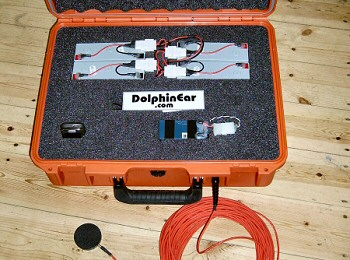Remote Monitoring
REMOTE MONITORING:
ENVIRONMENTAL MONITORING

Scottish Artist Katie Paterson setting up DolphinEar equipment at a glacial lake in Iceland
Several years ago, well known Scottish artist Katie Paterson came to us looking for help on a new project. She wanted to listen to the sound of a melting glacier and let people experience these sounds in real time.-
What they heard (listen yourself) was the sound of the popping of ancient air bubbles compressed and frozen into the ice thousands (or hundreds of thousands) of years ago. As the ice melts, the compressed air is released suddenly as a ‘pop’. That’s what you are hearing.
But those bubbles also tell another story. By listening to the number and pitch of those bubbles we can estimate the rate of melting. What was surprising is that we saw very little difference between the popping rate when we compared recordings made during the summer and winter periods. We would have expected the melt rate to be very much lower in the cold winter months. But it wasn’t.
This project also proved you could use weak mobile telephone signals in remote areas of the world to provide useful climate and monitoring data. Access from anywhere in the worlld is as simple as dialing a telephone number!
 MARINA SECURITY and HARBOUR SECURITY
MARINA SECURITY and HARBOUR SECURITY
DolphinEar hydrophones are being used to monitor boat and ship movements in and out of marinas and harbours. One or more hydrophones can be placed at key locations and either wired or radioed back to a central security building or guard shack.
(Please Note: Care must be taken when using DolphinEar in close proximity to boats as private conversations can sometimes be heard through the hull and are audible from several metres away.)

DolphinEar 600 equipment in self-contained waterprood case
 PERIMETER SECURITY
PERIMETER SECURITY
DolphinEar hydrophones are being used as waterproof microphones for ‘air’ and ‘ground’ applications for security purposes. They can be mounted on or cemented into walls to detect vehicles and voices. They can be buried in the ground to detect footsteps or other movements. There is an option for directly wiring the audio to a nearby guard shack or to the main dwelling, or it can be linked by radio.
 INFRASTRUCTURE MONITORING
INFRASTRUCTURE MONITORING
DolphinEar hydrophones make excellent waterproof contact microphones for monitoring sounds in large structures that help to identify developing faults. For example, suspension bridge cables are made from thousands of strands of steel cable. As the structure ages these strands begin to break due to the fatigue encountered by years of temperature changes and loading. When a contact microphone is installed on the cable a clear ping can be detected whenever one of these strands breaks. Monitoring the frequency of these pings gives engineers insight into the lifespan of the bridge and helps plans repair operations well in advance of failure. Similar changes in sound characteristics can be heard on road bridges, railroad bridges and other structures.

